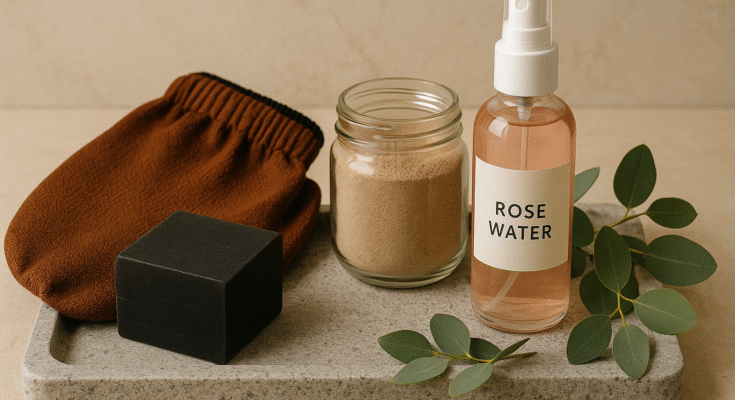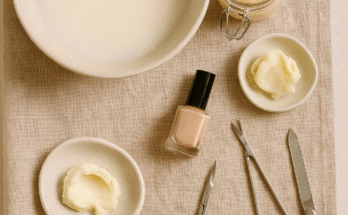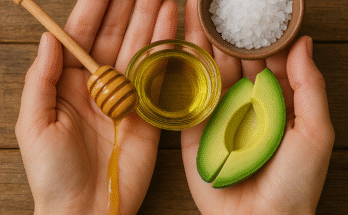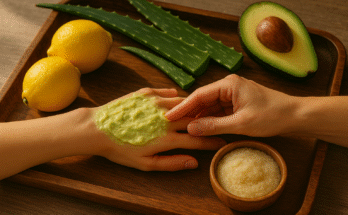The Ultimate Moroccan Hammam Experience: DIY Ritual for Glowing Skin
Transform your bathroom into a luxurious spa with this step-by-step guide to recreating the iconic Moroccan Hammam at home. This centuries-old ritual exfoliates, detoxifies, and rejuvenates skin, leaving it baby-soft and radiant—no travel required!
What You’ll Need
-
Black Soap (Savon Noir): A traditional blend of olive oil, salt, and potash rich in vitamin E.
-
Rhassoul Clay: Mineral-rich clay from Morocco’s Atlas Mountains.
-
Plain Yogurt: Lactic acid gently exfoliates; probiotics soothe irritation.
-
Honey: Deeply hydrates and fights bacteria.
-
Rose Water: Balances pH and calms inflammation.
Step-by-Step Ritual
1. Steam & Prep
-
Fill your bathtub or shower with hot water to create steam. Close windows and doors to trap humidity.
-
Sip water frequently and place a warm, damp towel on your neck and forehead to stay relaxed.
-
Soak in the steam for 10–15 minutes (exit if dizzy!).
2. Exfoliate with Black Soap
-
Apply black soap from feet to shoulders using circular motions. Avoid the eye and mouth areas.
-
Let it sit for 5 minutes to soften dead skin and impurities.
3. Scrub & Polish
-
Use a kessa glove or coarse washcloth to buff away dead skin in upward strokes. Rinse with warm water.
4. Clay Mask Detox
-
Mix rhassoul clay with yogurt and honey to form a smooth paste.
-
Apply to dry areas (elbows, knees) and face, avoiding eyes. Let dry for 5–10 minutes.
-
Rinse with cool water to tighten pores.
5. Final Touch: Rose Water
-
Spritz rose water over your body to lock in moisture and reduce redness.
Why the Moroccan Hammam Works
-
Deep Cleansing: Steam opens pores, while black soap dissolves dirt and excess oil.
-
Detoxification: Rhassoul clay draws out toxins and impurities.
-
Glowing Skin: Exfoliation boosts cell turnover, revealing brighter, smoother skin.
-
Stress Relief: The warm steam and rhythmic scrubbing melt away tension.
Black Soap Benefits
-
Exfoliates: Removes dead skin cells without stripping moisture.
-
Slows Hair Growth: Regular use weakens hair follicles over time.
-
Prepares Skin: Enhances absorption of serums and moisturizers.
Essential Ingredients for an Authentic Hammam
To replicate this ritual at home, you’ll need a few key ingredients, each with unique benefits:
-
Black Soap (Savon Noir)
-
What It Is: A velvety, olive oil-based paste enriched with crushed olives, eucalyptus, and potash (a natural alkali).
-
Why It Works: Potash gently dissolves dead skin cells, while olive oil nourishes and vitamin E repairs. Its antibacterial properties make it ideal for acne-prone skin.
-
Fun Fact: Traditionally, black soap is left to ferment for months, enhancing its efficacy.
-
-
Rhassoul Clay
-
Origin: Mined from the Atlas Mountains of Morocco, this mineral-rich clay has been used for over 1,400 years.
-
Benefits: Absorbs toxins, balances oil production, and contains magnesium, silica, and calcium to strengthen skin.
-
-
Kessa Glove
-
Purpose: A coarse, exfoliating mitt made from camel hair or synthetic fibers. It’s the secret to the Hammam’s legendary scrubbing power.
-
-
Rose Water
-
Role: A final hydrating spritz to soothe skin, reduce redness, and lock in moisture.
-
-
Pro Tips:
-
Hydrate: Drink herbal tea post-ritual to replenish fluids.
-
Frequency: Repeat every 2–4 weeks for maintained results.
-
DIY Upgrade: Add a few drops of argan oil to your clay mask for extra nourishment.
Embrace this ancient ritual to pamper your skin and soul. With each step, you’re not just cleansing—you’re honoring a tradition that’s celebrated beauty and wellness for generations. Your glow awaits!





